You are on CGS' Legacy Site.
Thank you for visiting CGS! You are currently using CGS' legacy site, which is no longer supported. For up-to-date information, including publications purchasing and meeting information, please visit cgsnet.org.
Landing Page
FOR IMMEDIATE RELEASE
Contact
Katherine Hazelrigg, CGS: (202) 462-3888 / khazelrigg@cgs.nche.edu
Washington, D.C. – Leaders of graduate institutions from 16 countries across six continents recently agreed on a set of principles and practical actions supporting graduate student mental health and wellbeing.
The statement was released at the conclusion of the 13th Annual Global Summit on Graduate Education, “Cultural Contexts of Health and Well-being in Graduate Education,” co-hosted by the Council of Graduate Schools (CGS) and the University of Manchester, with support from Educational Testing Service (ETS) and ProQuest. The Global Summit is an annual event designed to promote international best practices in master’s and doctoral education.
This year’s theme was chosen by an international steering committee to recognize the critical importance of graduate student mental health and wellbeing in a global context, a focus that can’t be answered using a single method or approach. Addressing these concerns while working to destigmatize mental health treatment has become a priority in the graduate education community, but to date, there has been no coordinated global effort to address this issue.
Summit participants shared examples and background on the national and international context of graduate student mental health and wellbeing in their countries and institutions.
Session topics addressed the organizational and administrative challenges to supporting graduate student mental health and wellbeing, including:
- Addressing national trends and perspectives in cultural attitudes, differences in terminology, current research, legal contexts, demographic differences, and health care systems;
- Creating a Campus Culture that Proactively Supports Wellness;
- Addressing the Role of Mentors and Advisors;
- Supporting “At-Risk” Student Populations; and,
- Prioritizing Professional Development and Career Counseling.
Professor Luke Georghiou, deputy president and deputy vice-chancellor at The University of Manchester, commented that, “Well-being and mental health issues among postgraduate researchers are high on the agenda at The University of Manchester. It has been immensely useful to have learned that this is a shared problem in all parts of the world, and most importantly to share experience on approaches to prevention and early detection of issues, and how to support students and staff in addressing them.”
CGS President Suzanne T. Ortega noted, “One of our shared goals is to foster learning environments that provide all current and future graduate students with the tools and support to succeed. Our discussions over the last two days brought to light new ideas and strategies to take back to our campuses.”
Participants in the summit included deans and other leaders of graduate schools and representatives of national and international associations devoted to graduate education. Along with the United Kingdom and the United States, the countries represented were: Australia, Belgium, Brazil, Canada, Chile, China, Egypt, Finland, Germany, Hungary, Malta, New Zealand, Rwanda, and South Africa.
The consensus statement and practical actions are attached.
###
About University of Manchester
The University of Manchester is a public research university in Manchester, England, formed in 2004 by the merger of the University of Manchester Institute of Science and Technology and the Victoria University of Manchester and is now the largest single-site university in the United Kingdom. Current enrollment at The University of Manchester is over 40,000 students, including 3,935 postgraduate research students.
About CGS
The Council of Graduate Schools (CGS) is an organization of approximately 500 institutions of higher education in the United States and Canada engaged in graduate education, research, and the preparation of candidates for advanced degrees. The organization’s mission is to improve and advance graduate education, which it accomplishes through advocacy in the federal policy arena, research, and the development and dissemination of best practices.
A growing body of evidence indicates that mental health challenges are common among graduate students. Unfortunately, many barriers exist to effective support and care. Beginning in 2019, CGS and The JED Foundation undertook a project to create an evidence base to inform future policies, programs and resources. Below are the results of that project, including the report, "Supporting Graduate Student Mental Health and Well-being: Evidence-Informed Recommendations for the Graduate Community."
Report and Recommendations
.png)
- Executive Summary and Recommendations
- "Supporting Graduate Student Mental Health and Well-being: Evidence-Informed Recommendations for the Graduate Community" (Final Report)
- Communications Toolkit
- Call to Action and List of Signatories (Updated December 13, 2021)
- Webinar: Supporting Graduate Student Mental Health and Well-being: Evidence and Recommendations to Catalyze Action (Recording and slides)
Consultant Papers
CGS and JED commissioned three essays on aspects of graduate student mental health and well-being. Authored by experts in their fields, these explore cultural and organizational issues surrounding graduate student mental health; issues specific to international students, and legal issues.”
-
"Unique Challenges and Opportunities for Supporting Mental Health and Promoting the Well-being of International Graduate Students" by Jenny J. Lee (University of Arizona)
-
"Promoting Graduate Student Wellbeing: Cultural, Organizational, and Environmental Factors in the Academy" by Julie R. Posselt (University of Southern California)
-
"Balancing Access and Safety for Graduate Students with Mental Health Issues" by Hannah S. Ross (Middlebury College)
Other Resources
- "CGS & JED Release Evidence-Informed Recommendations and Resources to Support Graduate Student Mental Health & Well-being" (Press Release)
- Webinar: "A Framework on Graduate Student Mental Health: CGS Members Share Ideas and Guidance" (3.16.2021)
- Hironao Okahana, "Pressing Issue: Mental Wellness of Graduate Students" (4.9.2018)
Contact
In Partnership with
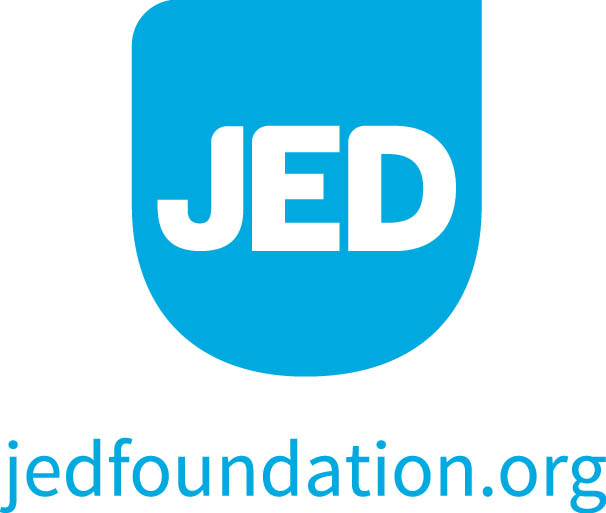
Project Funders
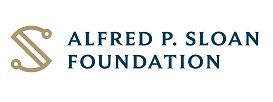

CGS, with support from ETS, has begun a new project, Supporting Diversity in Graduate Education: Next Steps in Advancing the International Agenda. This project grew out of the 2018 Strategic Leaders Global Summit on Graduate Education and aims to address the absence of a global effort to tackle diversity issues at master’s and doctoral institutions by cataloguing, classifying, and disseminating diversity initiatives through a digital repository.
Background
Even after decades of reform, the underrepresentation of women and minorities in graduate education remains a persistent problem across a variety of global higher education systems. National and regional organizations supporting graduate education have attempted to tackle this underrepresentation with different projects and approaches.
Addressing this gap was a goal of the 2018 Strategic Leaders Global Summit on Graduate Education co-sponsored by CGS, ETS, and the University of Johannesburg, which explored a range of issues related to diversity in master’s and doctoral education. Summit topics included clarifying and comparing definitions of diversity and inclusion, creating an inclusive campus and program culture, student recruitment, curriculum and pedagogy, retention and completion, and supporting successful career paths for all students. Under the theme, Supporting Diversity in Graduate Education, participants in the summit discussed current strategies for improving diversity, existing roadblocks, and future priorities.
In spite of the fact that national, community, and university systems confront unique challenges, and diversity often depends on national context, CGS and summit attendees agreed that the global graduate community would benefit from two areas of work: 1) Developing a system for classifying issues in diversity in graduate education and 2) Creating a resource library based on this taxonomy to include example policies, diversity metrics, research frameworks, promising practices, and case studies.
In March 2020, CGS and ETS released The Global Postgraduate Diversity Resource. The resources included on the website include essays from postgraduate leaders on diversity and inclusiveness as well as information from university diversity initiatives across the globe. You can access the diversity resource via this link. If you would like to submit a resource for consideration email Matthew Linton (mlinton@cgs.nche.edu).
Advisory Committee
Suzanne T. Ortega, President, Council of Graduate Schools
Alberto Acereda, Senior Director of Business Development, Educational Testing Service
Sue Berners-Price, Dean, Griffith Graduate School, Griffith University
Hans-Joachim Bungartz, Dean of Informations, Graduate Dean, Technical University of Munich
Karen Butler-Purry, Associate Provost, Graduate and Professional Studies, Texas A&M University
Carlos Gilberto Carlotti, Jr., Provost, Graduate Studies, University of São Paulo
Alexander Hasgall, Head, Council for Doctoral Education, European University Association
Nelson Ijumba, former Deputy Vice Chancellor, Academic Affairs and Research, University of Rwanda
Shireen Motala, Senior Director, Postgraduate School, University of Johannesburg
Susan Porter, Dean and Vice-Provost, Graduate and Postdoctoral Studies, University of British Columbia
Adham Ramadan, Dean, Graduate Studies, The American University in Cairo
Project support provided by
.jpg)
Cultural Contexts of Health and Well-being in Graduate Education
September 1-3, 2019
University of Manchester
The 2019 Summit theme, “Cultural Contexts of Health and Well-being in Graduate Education,” addresses a critical issue that affects graduate education leaders across the world. Several recent studies suggest that graduate students are at greater risk for stress and depression than those of the general population. One study found that 39% of surveyed graduate students suffered from depression, as compared to 6% of the general population. Other work indicates that graduate students’ mental health is more typical for their age groups. Most would agree that they face a range of challenges, including social isolation, imposter syndrome, concerns about job placement, and financial strains. Addressing these concerns while working to destigmatize mental health treatment has become a priority in the graduate education community, but many wonder where to begin.
The 2019 Global Summit on Graduate Education will address the many ways the international graduate education community currently works to support health and well-being in graduate education. We will also consider areas for improvement, including assessing points of intervention, training mentors, cultivating supportive environments, improving access to campus health services, and improving internal reporting structures. In addition, we will examine how individually and collectively we can improve upon these efforts for the benefit of students, universities, and broader communities.
Event Materials:
- Online Proceedings
- Statement of Principles and Practical Actions
- Press Release: University Leaders Issue Statement of Principles and Practical Actions to Promote Graduate Student Mental Health and Wellbeing
The 2019 Summit is generously sponsored by the Educational Testing Service (ETS) and ProQuest.
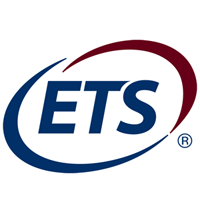

FOR IMMEDIATE RELEASE:
Contact: Katherine Hazelrigg, CGS: (202) 461-3888 / khazelrigg@cgs.nche.edu
Washington, DC — The Council of Graduate Schools (CGS) has announced that Charles Ambler, currently associate provost and dean of the Graduate School at The University of Texas at El Paso, has been named the CGS Dean-in-Residence for 2019-2020. Ambler has long been an advocate for diversity in graduate education, serving as a director of the McNair Scholars program at El Paso and leading a National Science Foundation (NSF) Alliances for Graduate Education and the Professoriate (AGEP) grant in collaboration with Howard University. He is a member of the boards of CGS and the Graduate Record Examination (GRE).
The CGS Dean-in-Residence program was created to infuse a campus-based perspective across a variety of the Council’s initiatives. The program offers an opportunity for graduate deans, associate, or assistant deans at member institutions to spend an academic year at CGS’s Washington D.C. office. Each year the CGS president selects one applicant to pursue projects aligned with the dean’s interests and the Council’s needs.
Dr. Ambler, a historian of Africa who has had visiting scholar appointments at universities in Africa and the United Kingdom, will help the Council build strategic relationships with graduate education leaders in sub-Saharan Africa. This work will support CGS’s broader goals of supporting diversity and inclusion and helping CGS members internationalize their campuses.
“Dr. Ambler has spent his academic career dedicated to student success, mentoring, and ensuring access to quality graduate education,” said CGS President Suzanne T. Ortega. “His expertise and leadership in African studies will help CGS members better understand the evolving place of sub-Saharan Africa in the global graduate education landscape.”
In accepting the appointment, Ambler noted that working at CGS represents “an exciting opportunity to combine my deep interests in both graduate studies and international education. The Council is an essential resource for anyone interested in graduate education, and I look forward to contributing to its mission.”
Ambler received his Ph.D. from Yale University and is author or editor of four books. In 2010, he served as president of the African Studies Association, the major professional organization for scholars, teachers, and practitioners with interests in Africa. He has served as dean at El Paso for fifteen years, during a period when UT El Paso reached R1 status. He will step down from the dean’s role and the CGS board in July; his Dean-in-Residence position begins on August 1.
###
The Council of Graduate Schools (CGS) is an organization of approximately 500 institutions of higher education in the United States and Canada engaged in graduate education, research, and the preparation of candidates for advanced degrees. The organization’s mission is to improve and advance graduate education, which it accomplishes through advocacy in the federal policy arena, research, and the development and dissemination of best practices.
Contact: Katherine Hazelrigg (202) 461-3888 / khazelrigg@cgs.nche.edu
Master’s and Certificate Programs Remain Most Affected
Washington, DC —New data from the Council of Graduate Schools (CGS) reveal that for the second consecutive year, international graduate application and first-time enrollment rates declined at U.S. universities. For Fall 2018, the final application counts from prospective international students declined by 4%, while the first-time enrollment of international graduate students declined by 1%.
The overall decline is primarily driven by a 6% decrease in applications and a 2% decrease in first-time enrollment to master’s and certificate programs. In contrast, first-time international doctoral enrollment grew by 3%. The discrepancy by degree objective is notable given the proportion of first-time international graduate enrollment in master’s and certificate programs (77%) vs. doctoral programs (23%).
“This is the first time we’ve seen declines across two consecutive years, and while we think it’s too soon to consider this a trend, it is troubling,” said CGS President Suzanne Ortega. “We continue to monitor issues, including changes in immigration and visa policy, with growing concern over the possible negative impact to the U.S.’s image as a welcoming destination for international students and scholars.”
Highlights by Country of Origin
China and India continue to represent the largest shares of international graduate applications, first-time international graduate enrollment, and total international graduate enrollment. However, the final application and first-time graduate enrollment of Indian students experienced large decreases again (-12%, -2% respectively) during the Fall 2017 to Fall 2018 admission cycle. This is the second consecutive year the number of applications and first-time enrollment from India has declined.
Graduate applications from Middle Eastern & North African students to U.S. graduate schools fell by 14% between the Fall 2017 and Fall 2018 admission cycles. Graduate applications and first-time enrollment of Iranian (-27%, -8%) and Saudi Arabian (-6%, -21%) graduate students also decreased. Conversely, applications and first-time enrollment of Sub-Saharan African graduate students increased by 28% and 5% respectively.
Ortega noted that overall, admission yield rates are comparable to last year. “This suggests that prospective international graduate students remain highly likely to accept offers of admission to U.S. graduate schools.”
Highlights by Field of Study
Across broad fields of study, international graduate applications increased in health sciences (5%), mathematics and computer sciences (6%), and other fields (8%) between Fall 2017 to Fall 2018. By contrast, engineering (-16%), physical & earth sciences (-9%), and business (-8%) experienced decreases in international graduate applications during this period. Business (95%), public administration & services (86%), and mathematics & computer sciences (85%) had high concentrations of first-time international students in master’s and certificate programs in Fall 2018, while first-time doctoral students accounted for 77% of international graduate students in physical & earth sciences and 50% in biological & agricultural sciences.
About the survey and report
Conducted since 2004, the CGS International Graduate Admissions Survey tracks the applications and enrollments of international students seeking U.S. master’s and doctoral degrees. As the only report of its kind to offer data on the current academic year, International Graduate Applications and Enrollment: Fall 2018 reports applications, admissions, and enrollments of international master’s, certificate, and doctoral students at U.S. colleges and universities. In Fall 2016 the survey was redesigned to collect data by degree objective (master’s and graduate certificate vs. doctorate), and for all seven regions of origin, eight countries of origin, and all eleven broad fields of study, yielding the only degree-level data currently available for graduate admissions and enrollments. 369 U.S. graduate institutions who are members of CGS or its regional affiliates responded to the 2018 survey.
# # #
The Council of Graduate Schools (CGS) is an organization of approximately 500 institutions of higher education in the United States and Canada engaged in graduate education, research, and the preparation of candidates for advanced degrees. The organization’s mission is to improve and advance graduate education, which it accomplishes through advocacy in the federal policy arena, research, and the development and dissemination of best practices.
Hironao Okahana, Associate Vice President, Research & Policy Analysis & Enyu Zhou, Education Research Analyst, Council of Graduate Schools
According to the 2018 CGS/GRE Survey of Graduate Enrollment and Degrees (GE&D), first-time graduate enrollment of international students at participating institutions declined by 3.7% between Fall 2016 and Fall 2017. This brief highlights some additional analysis pertaining to international graduate enrollment trends.
Key Findings:
- Despite the 3.7% decrease overall, at Doctoral Universities: Highest Research Activity (R1), first-time international graduate enrollment increased by 1.4% between Fall 2016 and Fall 2017. At other types of institutions, however, first-time international graduate enrollment decreased by double digits. (Figure 1)

- Compared to R1 institutions, proportionally fewer international graduate students attend other types of institutions. However, in some fields of study, such as engineering and mathematics and computer sciences, a large number of incoming graduate students at non R1 institutions are also international. (Figure 2)
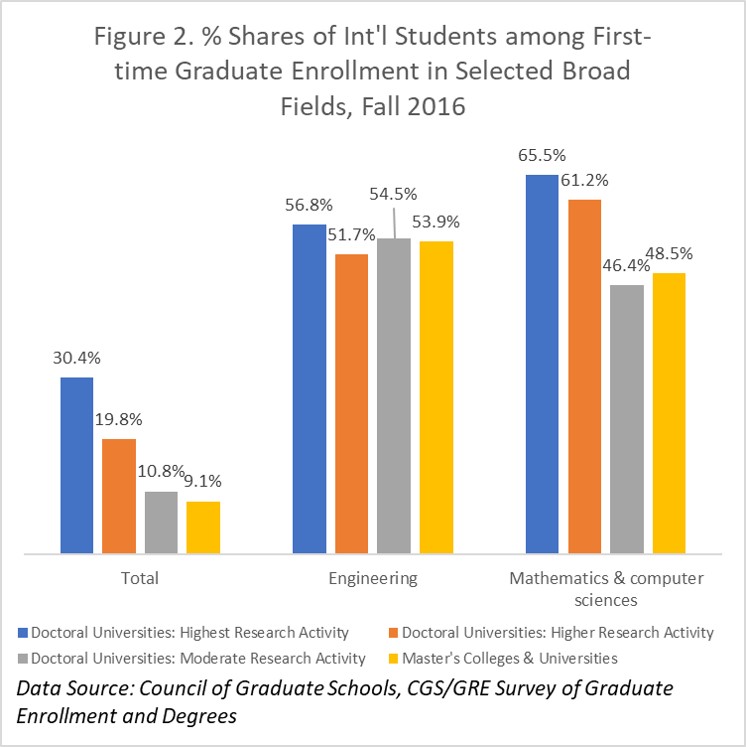
- At R2 and R3 institutions, domestic first-time enrollment also declined between Fall 2016 and Fall 2017, and overall first-time graduate enrollment decreased by 4.2% and 7.1%, respectively. While there are fields in which first-time enrollment has been declining for some years, there are others that saw a sudden decline between Fall 2016 and Fall 2017. (Table 1 – next page)
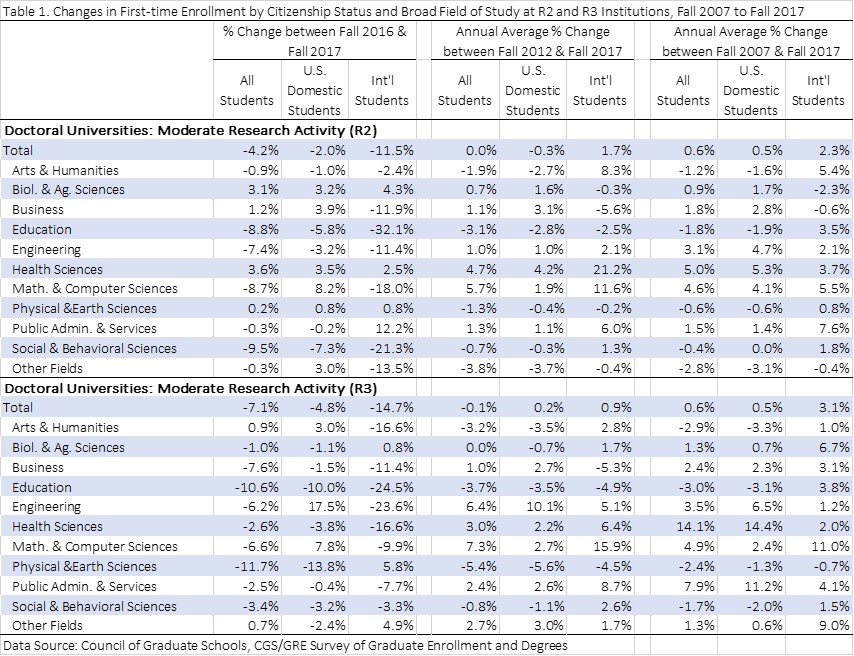
Takeaway Points:
- A number of factors influence the global academic mobility of students; the Fall 2017 enrollment data suggest that the current U.S. visa policy and the uncertainties surrounding it may be, in part, impacting the flow of international graduate students coming into the United States.
- It appears that U.S. graduate education, broadly speaking, is still attractive to international talents, as is evident from first-time international graduate enrollment at R1 institutions. For other types of U.S. institutions, given the current political and policy climate, global competition for international graduate students may have increased.
- For R2 and R3 institutions, the decline of first-time international graduate enrollment comes in addition to stagnating, if not declining, first-time graduate enrollment of U.S. domestic students. If this decline becomes a pattern, it could pose a significant challenge to the health of graduate programs, particularly those programs with a large number of international students.
Conversation Starters: What do these data points mean for your graduate school and your programs and their strategic directions?
- How does your institution’s international and domestic enrollment figures compare to the national numbers? How does your institution compare to your peer institutions and graduate programs regionally and nationally?
- How have international graduate recruitment strategies at your institution changed in recent years? Has your institution historically relied on specific countries and/or graduate programs for international recruitment? How do you continue to strategically position your graduate school/programs in an increasingly crowded international marketplace?
- How are your graduate school and your programs responding to changes in both domestic and international graduate student enrollment? Do your graduate school and programs proactively engage current and potential employers of graduate degree holders?
Additional Resource:
CGS Strategic Consultations. The Council of Graduate Schools provides strategic consultations to member and nonmember institutions, boards, and state agencies as they make tactical decisions about the administration of graduate education. Our consultations draw upon extensive best practice and benchmarking research as well as the insights of experienced graduate deans from around the country. CGS also provides Custom Data Reports to help institutional leaders inform their strategic decision-making processes. Figures and tables in this brief and the full GE&D report can be customized to include institutions of your choice.
About the Data Source:
CGS/GRE Survey of Graduate Enrollment and Degrees is an annual survey of U.S. graduate schools, co-sponsored by CGS and the Graduate Record Examinations (GRE) Board since 1986. It is the only annual national survey that collects data on graduate enrollment by all fields of study and is the only source of national data on graduate applications by broad field of study. The report includes responses from 619 institutions and presents statistics on graduate applications and enrollment for Fall 2017, degrees conferred in 2016-17, and trend data for one-, five- and ten-year periods.
The brief was prepared by Hironao Okahana and Enyu Zhou. Ryan Bradshaw and Katherine Hazelrigg also contributed. Any opinions, findings, and conclusions or recommendations expressed in this brief do not necessarily reflect the views of CGS.
PRESS RELEASE
EMBARGOED UNTIL: October 18, 2018 at 12:01 a.m. EDT
Contact: Katherine Hazelrigg
(202) 461-3888 khazelrigg@cgs.nche.edu
Washington, DC – The Council of Graduate Schools today released a research brief that reports on humanities PhD holders’ perceptions of the relevance of their doctoral programs to their current jobs. The brief, which draws on data from the CGS PhD Career Pathways project, indicates that the vast majority of humanists, regardless of employment sector, believe their doctoral education prepared them well for their current jobs.
Key Findings:
- Three years post-PhD, humanists working in non-academic jobs saw their training less aligned with their jobs than did those in academia; 52% of those in non-academic jobs reported that their PhD prepared them well for their current job, as compared to 77% of those in academia. For humanities PhDs eight- and 15-years postgraduation, however, there was no statistical difference in perception of preparation between those working in academia and those working elsewhere.
- Most humanities PhDs would pursue a PhD in general or in the same field, if they had to start over again.
- Between humanities PhDs working in academia and those working elsewhere, there are more similarities than differences in key skills and attributes important for successfully performing work. Attributes such as “leadership,” “adaptability and flexibility,” and “analytical thinking” were rated as almost identically important across both groups.
The findings are based on survey responses from 882 doctoral degree recipients from 35 institutions; fields included Anthropology and Archeology, English Language and Literature, Foreign Language and Literature, History, Philosophy, Religion and Theology, and Arts and Humanities. The data were collected as part of the project Understanding PhD Career Pathways for Program Improvement and represent a small subset of the data available.
“While these findings represent the first wave of our data, they provide a strong indication that humanities PhDs find their training relevant to diverse career contexts,” said CGS President Suzanne Ortega. “Perhaps the most intriguing finding is that people eight and 15 years out of their PhDs find their training more relevant to their jobs than the earlier cohort.”
It’s not clear whether alumni views grow more positive over time because they have had the time to find a job that is a better fit for their skills, or whether those eight- and 15-years post-graduation come to have a different appreciation of their preparation. “Whatever the reason,” said Ortega, “this is good evidence that recent PhDs can use extra support in finding a job that’s right for them.”
This phase of PhD Career Pathways builds upon a decade of CGS initiatives dedicated to illuminating PhD career pathways and encouraging universities to value diverse career options for graduate students. Previous research from the Council of Graduate Schools conducted in partnership with the National Endowment for the Humanities indicates that humanities programs can successfully broaden options and opportunities for humanities PhDs by choosing vocabulary that supports the goals of PhD career diversity (e.g., using the term “flexible career paths” instead of “Plans A and B”); actively listening to and engaging important voices (such as students, alumni, and faculty); developing external partnerships; and removing administrative roadblocks.
CGS plans to release additional research briefs this fall that will include all fields of study, and in early 2019, the first results from a survey of PhD students in their second and fifth years of study.
About the project:
CGS PhD Career Pathways is a coalition of 65 doctoral institutions working to better understand and support PhD careers across all broad fields of study. Universities collect data from current PhD students and alumni using surveys that were developed by CGS in consultation with senior university leaders, funding agencies, disciplinary societies, researchers, and PhD students and alumni. The resulting data allow universities to analyze PhD career preferences and outcomes at the program level and help faculty and university leaders strengthen career services, professional development opportunities, and mentoring. Additionally, participating universities are able to compare their data on PhD career preferences and outcomes with CGS’s national dataset.
This project is supported by The Andrew W. Mellon Foundation (grant #31600612) and the National Science Foundation (grant #1661272).
###
The Council of Graduate Schools (CGS) is an organization of approximately 500 institutions of higher education in the United States and Canada engaged in graduate education, research, and the preparation of candidates for advanced degrees. The organization’s mission is to improve and advance graduate education, which it accomplishes through advocacy in the federal policy arena, research, and the development and dissemination of best practices.
Any opinions, findings, and conclusions or recommendations expressed in this material are those of the author(s) and do not necessarily reflect the views of The Andrew W. Mellon Foundation or the National Science Foundation.
PRESS RELEASE
EMBARGOED UNTIL: October 3, 2018, 12:01 a.m. EDT
Contact: Katherine Hazelrigg / (202) 461-3888 / khazelrigg@cgs.nche.edu
Washington, DC — Today the Council of Graduate Schools (CGS) reported that growth in first-time graduate enrollment remains flat, according to its most recent data, while the number of graduate applications to U.S. universities has decreased. Between Fall 2016 and Fall 2017, first-time graduate enrollment dropped by -0.1% and the number of applications for admission to U.S. graduate schools decreased -1.8%. Although the overall number of applications for admission declined, several broad fields of study saw increases, including business (4.5%), public administration and services (1.9%), education (1.8%), and mathematics and computer sciences (1.7%). The data is part of the latest CGS/GRE Graduate Enrollment & Degrees: 2007-2017 report.
Decrease in International Enrollments
First-time graduate enrollment for U.S. citizens and permanent residents increased 1.1% between Fall 2016 and Fall 2017. In contrast, first-time graduate enrollment of international students decreased -3.7%, but the five-year (4.7%) and ten-year average annual increase (5.6%) rates remain strong. Universities with an R1 Carnegie Classification, or highest research doctoral institutions, saw no negative impacts, posting a 3.0% increase between Fall 2017 and Fall 2017.
“The decrease in application and flat first-time enrollment rates are not unexpected given the robust economy and job market. After years of steady growth, the slow down aligns with typical cycles in the economy,” said CGS President Suzanne Ortega. “What is worrisome, however, is the decline in the number of international students pursuing graduate education in the U.S. The 3.7% drop in first-time enrollment between Fall 2016 and Fall 2017 is the second consecutive decrease we’ve seen since 2003. While it is difficult to pinpoint what caused the decline, the current policy climate around U.S. visas and immigration may be a contributing factor.”
Enrollments Align with Fastest Growing Fields
Enrollment trends by broad field of study are consistent with last year. The largest one-year gains in first-time enrollment by broad field of study were in mathematics and computer sciences (3.8%) and business (3.7%) between Fall 2016 and Fall 2017. The largest five- and ten-year average (2012-2017) percent changes by broad field were in mathematics and computer sciences (12.8%, 12.1%) and the health sciences (4.0%, 6.9%). In contrast, the one-year change in first-time graduate enrollment in engineering was -3.8%, compared to -0.9% between Fall 2015-2016; engineering also posted the biggest application decline in the one-year period (-7.3%). These results are consistent with CGS’s International Graduate Applications and Enrollment: Fall 2017, indicating that the decline in engineering enrollment is largely driven by a decrease in international students.
“The continued growth in applications and first-time enrollment in the health sciences indicates graduate education is aligning with the increasing workforce demand for advanced degree holders,” said Ortega. “According to the most recent Bureau of Labor Statistics data on employment projections, many of the fastest growing fields are in mathematics and computer sciences and the health sciences, including physician assistants, occupational therapists, mental health and substance abuse social workers, mathematicians, and computer and information research scientists. These jobs all require at least a master’s degree for a typical entry-level position.”
Institutions responding to the CGS/GRE Survey of Graduate Enrollment & Degrees for Fall 2017 enrolled more than 1.8 million graduate students. Nearly three quarters (74.0%) of total graduate enrollment was in master’s programs. Over one million of those graduate students, or 57.9%, were women. Academic year 2016-17 marked the eighth consecutive year in which women earned the majority of degrees awarded. However, in many STEM fields, men still earned the majority of graduate degrees and certificates.
Other report findings are summarized below.
Findings by Broad Field
- The three largest broad fields of study: business, education, and health sciences, were also the fields with the largest proportions of part-time graduate students.
- Graduate applications decreased in engineering (-7.3%), arts and humanities (-1.8%), physical and earth sciences (-0.6%), and biological and agricultural sciences (-0.4%) between Fall 2016 and Fall 2017.
- The largest one-year increases in graduate applications occurred in the broad fields of business (4.5%), public administration and services (1.9%), education (1.8%), and mathematics and computer sciences (1.7%).
Findings by Degree Level
- About 70% of the applications received for Fall 2017 were to master’s/other programs. The large majority of all first-time graduate students in Fall 2017 were enrolled in programs leading to a master’s degree or a graduate certificate (83.4%).
- The number of doctoral degrees awarded increased 1.7% and the number of master’s degrees awarded increased 4.6% between 2015-16 and 2016-17.
- The largest one-year percent increases in master’s degrees were in mathematics and computer sciences (13.6%), health sciences (4.7%), and “other fields” (4.7%).
Findings by Student Demographics
- In Fall 2017, approximately 23.9% of all first-time U.S. citizens and permanent resident enrollees were underrepresented minorities. American Indian/Alaska Native, Black/African American, and Hispanic/Latino first-time graduate students remain particularly underrepresented in STEM fields.
- In Fall 2017, the majority of first-time graduate students at all degree levels were women – 59.2% at the master’s degree and certificate level and 53.5% at the doctoral level.
- Among first-time graduate enrollment, 79.7% were U.S. citizens and permanent resident graduate students in the Fall of 2017 and about 20.3% were international.
- International students comprised the largest share of first-time graduate students in mathematics and computer sciences (56.3%), followed closely by engineering (52.9%).
About the report
Graduate Enrollment and Degrees: 2007 to 2017 presents the findings of an annual survey of U.S. graduate schools, co-sponsored by CGS and the Graduate Record Examinations (GRE) Board. It is the only annual national survey that collects data on graduate enrollment by all fields of study and is the only source of national data on graduate applications by broad field of study. The report includes responses from 619 institutions and presents statistics on graduate applications and enrollment for Fall 2017, degrees conferred in 2016-17, and trend data for one-, five- and ten-year periods.
###
The Council of Graduate Schools (CGS) is an organization of approximately 500 institutions of higher education in the United States and Canada engaged in graduate education, research, and the preparation of candidates for advanced degrees. The organization’s mission is to improve and advance graduate education, which it accomplishes through advocacy in the federal policy arena, research, and the development and dissemination of best practices.
Hironao Okahana, Associate Vice President, Research & Policy Analysis, Council of Graduate Schools
The latest national data suggest that increasingly more former Pell recipients—thus, students from low-income backgrounds—are pursuing graduate and professional programs. However, the data also suggest that many of them begin their advanced education with sizeable undergraduate debt and continue to rely on student loans to finance their education. Graduate schools should proactively help these students make informed financial aid decisions and manage and reduce their borrowing and debt.
Introduction
The sociodemographic diversity of the graduate student body has evolved over time. Though still disproportionally underrepresented, we reported in the CGS/GRE Survey of Graduate Enrollment & Degrees that first-time enrollment of traditionally underserved students of color continues to grow. Graduate schools continue to make efforts to ensure a more diverse and inclusive student body through a number of initiatives. Another indicator of sociodemographic diversity in higher education is the Pell ratio, that is, the proportion of the student body who receives Pell Grants. This indicator is commonly used to assess sociodemographic diversity of undergraduates since the Pell Grant has income requirements and is specifically targeted to low-income students. Because graduate students are not eligible for Pell Grants, typically we do not closely observe this figure. Nevertheless, looking at proportions of former Pell recipients among graduate students can offer additional insight into the accessibility of graduate education for those from low-income backgrounds.
In May 2018, the National Center for Education Statistics (NCES) released the PowerStats version of the 2015-16 National Postsecondary Student Aid Study (NPSAS:16). PowerStats is an online tool that allows researchers to generate data tables and some analyses using various NCES sample surveys, including NPSAS. NPSAS is a nationally representative sample study of financial support for all students at U.S. institutions of higher education. NCES conducts this study every three to four years, and the most recent one, NPSAS:16, captures one of the most comprehensive looks at how undergraduate and graduate students were financially supported during the Academic Year 2015-16. As points of comparison, I also looked at two earlier cohorts: NPSAS:08 and NPSAS:12, which respectively offer snapshots of students in Academic Years 2007-08 and 2011-12.
More Former Pell Recipients at Graduate and Professional Schools
Table 1 summarizes the percentage shares of former Pell recipients among first-year graduate and professional students by selected degree programs. According to NPSAS:16, 45.8% of first-year graduate and professional students received Pell Grants at some point. This is an increase from a little under one-third (32.5%) for the NPSAS:08 cohort and 35.9% for the NPSAS:12 cohort. In all types of graduate and professional programs, the shares for former Pell recipients among first-year students increased when compared to NPSAS:08 and NPSAS:16 cohorts. The shares of former Pell recipients among first-year students in the NPSAS:16 cohort were particularly high in master of public administration or policy (64.2%), master of social work (63.3%), and master of education or teaching (54.5%) programs. Of the first-year students in doctor of philosophy and doctoral degree – professional practice (e.g., MD, JD, DDS, etc.) programs, 41.7% and 39.8%, respectively, were former Pell recipients in the NPSAS:16 cohort. These changes are encouraging signs that the increasing number of students from low-income backgrounds are moving beyond baccalaureate education and pursuing graduate and professional degrees.

Former Pell Recipients Are More Likely to Take out Student Loans
However, the data, which are summarized in Table 2, also suggest that these former Pell recipients among first-year graduate and professional students come with greater financial needs for their advanced education than their counterparts. Among the first-year students in the NPSAS:16 cohort enrolled in various graduate and professional programs, 69.7% of former Pell recipients took out student loans during the 2015-16 academic year. 37.6% of students who never received Pell Grant borrowed toward their advanced education in the same year. The discrepancy was the largest for first-year students in Master of Arts (MA) degree programs. Nearly three-fourths (73%) of former Pell recipients among those MA students took out student loans during the 2015-16 academic year, while only 29.3% of non-former Pell recipients did the same. The median amount borrowed by former Pell recipients who were first-year students in MA degree programs was $18,444, while the median amount borrowed by their counterparts without Pell Grant debt was $13,195. The difference in amount borrowed between former Pell recipients and non-recipients was the smallest among first-year students in doctoral degree – professional practice (e.g., MD, JD, DDS, etc.) programs. Among those who were pursuing doctoral degrees – professional practice, the median amount borrowed by former Pell recipients was $39,106 while the median amount borrowed by non-former Pell recipients was $35,000.

Bigger “Baggage” of Former Pell Recipients
Even before borrowing for their advanced education, as summarized in Table 3, these former Pell recipients arrive at graduate and professional schools with larger amounts of undergraduate debt. More than three quarters (77.2%) of first-year master’s students who formerly received Pell Grants carried outstanding balances from their undergraduate loans, with the median amount of $28,131. This is compared to only 31.2% of their counterparts who never received Pell Grants carrying outstanding balances for their undergraduate debt. Furthermore, the median amount still owed for the latter group was substantially smaller at $18,964. Median amounts still owed on undergraduate debts exceeded $30,000 for first-year students in master of social work ($33,658), master of business administration ($33,352), master of arts ($31,584), and doctor of philosophy ($30,228) programs. Students can defer repayment of their federal student loans while pursuing advanced degrees; however, unsubsidized portions of loans still accrue interest during deferment. The debts former Pell recipients carry over from their undergraduate education, compounded by potential unmet financial needs toward their graduate and professional education, could prevent them from fully realizing the upward social mobility often associated with attaining advanced degrees.

Discussion
An increasing number of former Pell recipients entering graduate and professional programs is a welcome sign. However, it is clear many of these students arrive to graduate school with sizeable undergraduate debt. At the federal-level, the vast majority of financial aid for graduate and professional students comes in the form of loans. Absent federal need-based grants for graduate and professional students that mirror the Pell Grant program for undergraduates, it is no surprise that former Pell recipients are more likely to borrow for their advanced education. Simply limiting the ability of graduate and professional students to borrow would take away one of few aid options for students with the most financial need. What we should encourage, instead, is more informed decisions.
Graduate students need to be aware of how their undergraduate and graduate debts interact with one another, and how to manage both while in school and upon completing their degrees. Thus, CGS advocates at the federal-level for establishing procedures that support master’s and doctoral students in making informed financial aid decisions to reduce their borrowing and debt. Graduate schools, too, can play a role in preparing students to actively manage their personal finances and make informed decisions about saving, spending, and borrowing.
However, debt management alone can only go so far in ensuring access and affordability of graduate education for students from low-income backgrounds. Thus, CGS advocates for extending Pell eligibility to those graduate students who remain income eligible and did not exhaust 12 semesters of Pell while pursuing their undergraduate education. In the NPSAS:16 cohort, only 6.5% of domestic graduate students have received Pell Grants for six years or more. What we advocate would allow the 34.6% who did not use all 12 semesters of Pell Grants to apply their remaining semesters toward their graduate education, as long as they also remain income eligible. This is one way to alleviate their borrowing toward graduate education, thus reducing overall education debts.




